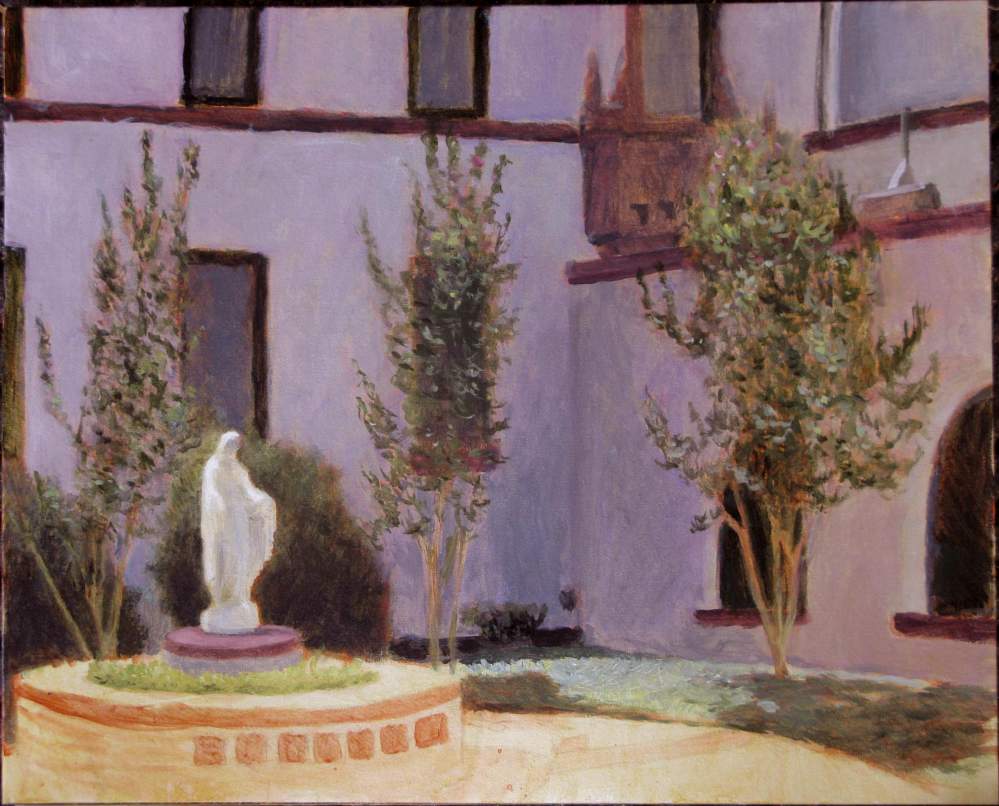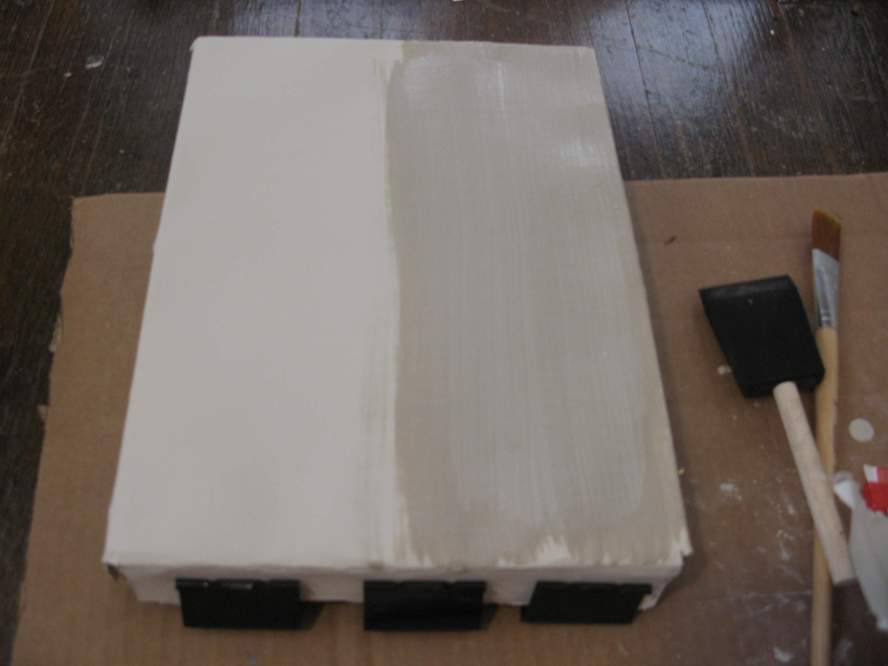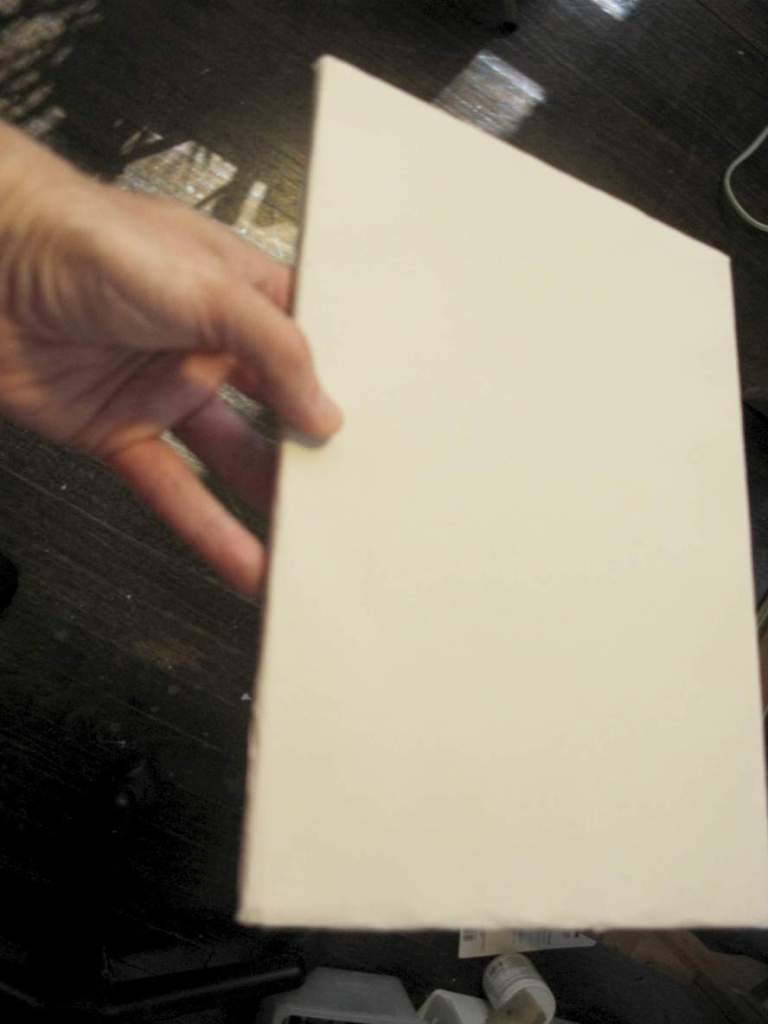I entered two recent paintings into a local art show, Courtyard at St Mary’s and Streetcorner of 2nd & Central. They will be on exhibit at the Czech Heritage Museum in Temple, TX until June 28, and then move to the Bell County Museum in Belton until August, and back to Temple to the Railroad Museum until October. Catch the show if you’re in the areas.

Drawing Final: Sharisse Sitting
April 26, 2024I’m going to stop here on this drawing. I did a little more scratching on the back wall, and decided to fill in the dark areas using charcoal. Her hair was rendered with a Wolff pencil, and the background with a large piece of soft charcoal. I had planned to use a white pastel on the blanket she’s sitting on, but I’m fond of how the undertone looks, and didn’t want to cover that up. I’ll let her sit a while longer as I clean up some spots, but consider it mostly done.

Drawing Started: Sharisse Sitting
April 21, 2024I’ve started a new drawing using the clay coated paper scratchboard I made in the video I posted last time. This is from an photo of mine that I took of my friend, Sharisse, sitting on the floor of her apartment. The grey tone is a wash of diluted sumi ink. I lightly outlined the figure on the paper with a grey pastel pencil to get her placed the way I wanted, and used the box cutter blade to roughly lighten the brightest areas. I then scratched over that with a push pin. It’s still a little rough on the modeling of her figure, but I’ll refine that later as I move on to the blanket and background areas. I’ll make a last pass on the darks at the end; although, I rather like it without that right now. We’ll see what it looks like when I get to that point.

Video for Clay Coated Paper
April 16, 2024I’ve gotten around to making another video on YouTube. This one demonstrates how I prepared a clay coated surface for drawing using thin coats of air-dry clay. Although this is specially made for ink drawing, it also works well for painting; however, if you want to use it with oils you would need to properly size the paper first. Feel free to leave a comment, and “like” if you find it useful.

Android Tablet for the Studio
March 20, 2024
For a few years now I’ve been using a digital picture frame viewer in the studio as a means to display reference photos while I work. Unfortunately, recently it stopped working, so I looked for a replacement. At first I thought I’d just get another cheap viewer that just shows pictures, but I wasn’t too crazy about the poor color accuracy, so I decided to look into getting a tablet. I found this one online for just under $50 new. It came today, and was easy to set up. It’s an Android tablet slightly bigger than the old viewer. at 10″. I need to find a stand for it, or may make one.

Painting Final: St Mary’s Courtyard
March 18, 2024
Painting Update: St Mary’s Courtyard
March 15, 2024
Making progress on the new painting. I’ve colored in most of the background and the statue. There will be much more refining of details here and there later, but this gives me the direction I need to see how to bring this all together. I like the contrast of the statue to the background. She pops out with good dimension. All of of this was made with Open acrylics. I’ll work more on that top corner next, and then the foreground area.

New Painting Started: St Mary’s Courtyard
March 14, 2024
I’ve started a new painting. It’s based on some photos that I made of a courtyard at a local Catholic church that has a statue of Saint Mary. I’m planning to enter it in a local exhibit where the painting is due for delivery on the first week of April, so there’s a bit of a deadline. I think I can make it. I decided to do this one using Golden’s Open acrylics, but I started this layer using Turner’s acrylic gouache. The surface is canvas mounted to foamcore, 16 x 20″.

New Painting: Street Corner Bench
March 9, 2024
Painting Final: Eye Doctor Wait Room
March 3, 2024I’m considering this finished; although, there’s room for some clean up and details if I decide to add that. Right now I like the loose sketchiness of it, so I’ll leave it alone for a while. It accomplished what I set out to do, which was to test out this new clay coated surface I made. That has held up really well. No flaking, cracking, or lifting of the surface when wet. It behaved just fine, and takes paint well.

New Painting Started: Eye Doctor Wait Room
March 1, 2024Finally got all the interrupting chores out of the way to start a new painting on the clay coated paper I created in the previous post. This is based on a drawing of a photo I took at a local doctor’s office, showing two elderly people in the waiting room. I decided to start off with a blue wash since the majority of the final local colors will be in warm tones. That color is not all that important in the end, as most of it will be covered up, so it’s mostly used to roughly help place the shapes and values. The clay coating is holding up well under this wash. We’ll see how well it does with gouache I plan to paint over it next.

Painting on Activa Clay Continued
February 20, 2024This picture shows the Activa Supreme tile I made in the previous post that has now been mounted to a thin piece of plywood cut to the same size. This adds a little more weight to the tile, but not much, and has a better benefit of adding strength to resist cracking or damage. It’s now ready for painting, but before I get to that I wanted to test out another idea of creating a paint surface with this air-dry clay.

In this photo I’m painting thin coats of the clay onto a stretched sheet of paper. I’ve made a wet “slip” from the Activa clay by adding water to create a slurry that’s approximately 40% water. I do what I refer to as double coats much like how I apply traditional gesso, which is one thin coat in one direction that I let dry before adding another coat in the opposite direction. I repeat this nine times so that there are essentially eighteen thin coats on this sheet of paper.

Here is the finished surface with eighteen coats. It took about an hour to “paint” this slip in this manner. Ceramicists are familiar with clay slip for making repairs or adding decorations to their pottery, and this is roughly the same thing. There is also a way to make a thicker casting slip to pour into a mold, but it requires using deflocculants to keep the drying clay from cracking. I didn’t want to get into that. Painting the slip onto the paper in this way let me avoid any cracking issues. I could have painted this directly on a more firm surface rather than paper, but this slip is very wet and I’d likely have problems with that much water causing a board to warp and twist, which is not good for dried clay. In the photo above notice that I laid a piece of the tile sample on the corner, and that tile is slightly darker than the slip coated paper. Not sure why this is, since it’s the same material, and it’s opaque enough that the paper shouldn’t show through. Interesting.
Here I have removed the slip covered paper from the frame, and mounted it to a thin sheet of foamcore. This will give it the firmness I need without the extra weight of using plywood or hardboard. I will need to lightly sand this surface a little to smooth it out a bit, and then it will be ready for painting.
One of the issues I had comparing the tile I made with the Permastone or Wood putty casting material for painting is that this air-dry clay was more expensive by volume when made into an equal sized tile. However, using this slip method eliminates that problem. I estimate I only used about half a pound of clay to make enough slip to coat this sheet of 9 x 12″ paper. So, from that chunk of clay I should have enough to make 6 or 7 sheets at that size.
Finally ready now to do some painting on these, but first thing is to spend some time cleaning up the studio. It’s a mess in there.










